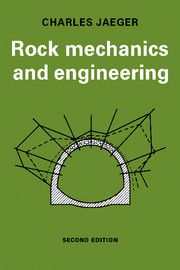Book contents
- Frontmatter
- Contents
- Preface
- Preface to the first edition
- Part 1 Introduction to rock mechanics
- 1 The historical development of rock mechanics
- 2 Engineering geology and rock mechanics
- Part 2 Rock material and rock masses
- Part 3 Rock mechanics and engineering
- Part 4 Case histories
- References
- Appendix 1 Comments on the bibliography
- Appendix 2 Measurement conversion tables
- Appendix 3 Table of geological formations and earth history
- Appendix 4 Some petrographic properties of rocks
- Author Index
- Index of geographical names, dam sites, reservoirs, tunnels and caverns
- Subject Index
2 - Engineering geology and rock mechanics
Published online by Cambridge University Press: 04 August 2010
- Frontmatter
- Contents
- Preface
- Preface to the first edition
- Part 1 Introduction to rock mechanics
- 1 The historical development of rock mechanics
- 2 Engineering geology and rock mechanics
- Part 2 Rock material and rock masses
- Part 3 Rock mechanics and engineering
- Part 4 Case histories
- References
- Appendix 1 Comments on the bibliography
- Appendix 2 Measurement conversion tables
- Appendix 3 Table of geological formations and earth history
- Appendix 4 Some petrographic properties of rocks
- Author Index
- Index of geographical names, dam sites, reservoirs, tunnels and caverns
- Subject Index
Summary
The geologist's approach to rock mechanics
An American geologist, Professor Kiersch (1963), submitted to the annual Congress of the Austrian Society of Rock Mechanics in Salzburg (1962), a most interesting paper on the trends of engineering geology in the United States and on the modern teaching methods introduced at several American universities for training the new generation of engineering geologists. At the same meeting Professor Bjerrum, from Norway, speaking on behalf of A. Casagrande (President of the International Conference on Soil Mechanics) brilliantly explained how rock mechanics should be integrated into soil mechanics as a mere chapter of a wider, more advanced technical science. The Congress reacted by deciding to expand their own efforts and to form the nucleus of an International Society of Rock Mechanics.
Rock mechanics adopts many of the techniques developed in soil mechanics based on the simple law of Coulomb which related shear strength of elastic materials to the friction factor and the normal stress. But the behaviour of rocks is far more complex than the behaviour of soils, and in many cases rock mechanics uses techniques unknown in soil mechanics. The two are parallel but distinct chapters of the science of discontinuous spaces as opposed to the classical theory of strength of materials assuming a continuous space. The links between rock mechanics, engineering geology and classical geology are even more intricate and complex. It is not possible to think about rock mechanics without examining and discussing these links.
- Type
- Chapter
- Information
- Rock Mechanics and Engineering , pp. 5 - 26Publisher: Cambridge University PressPrint publication year: 1979



